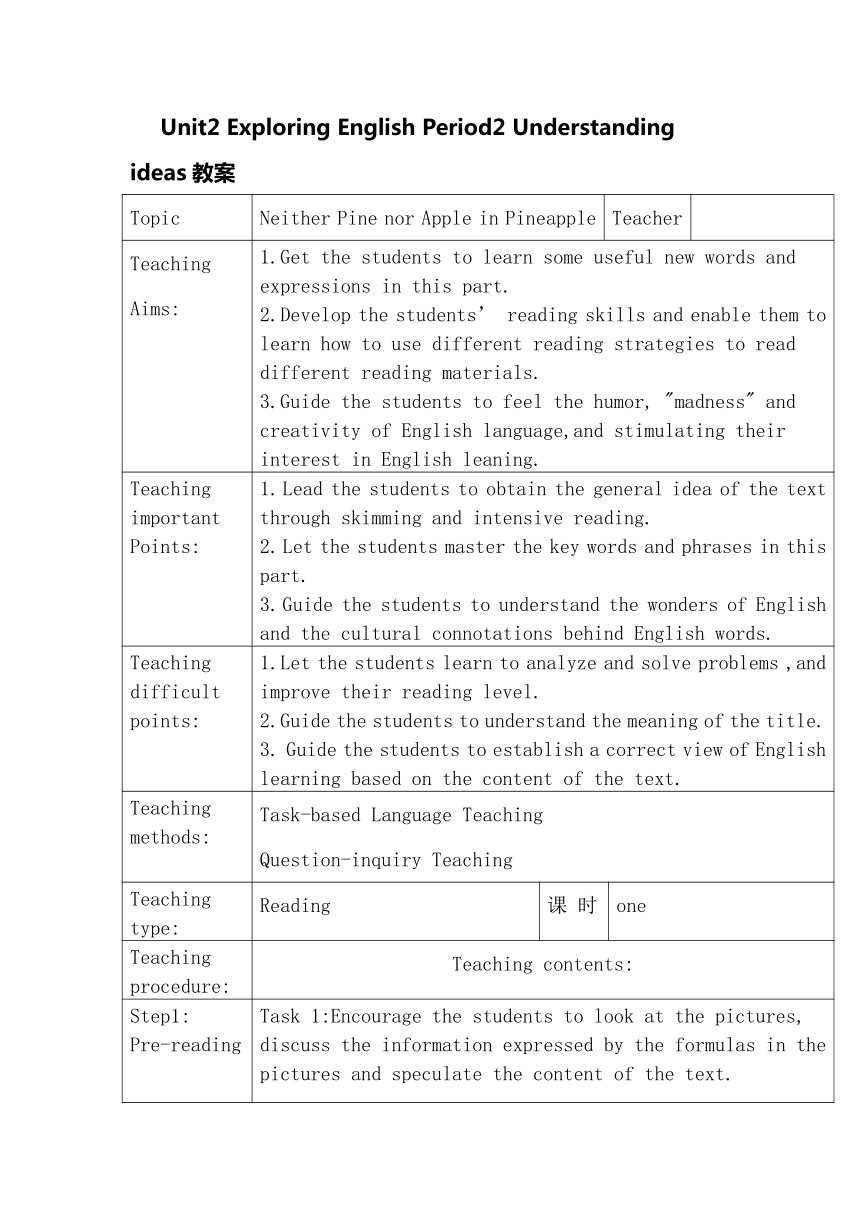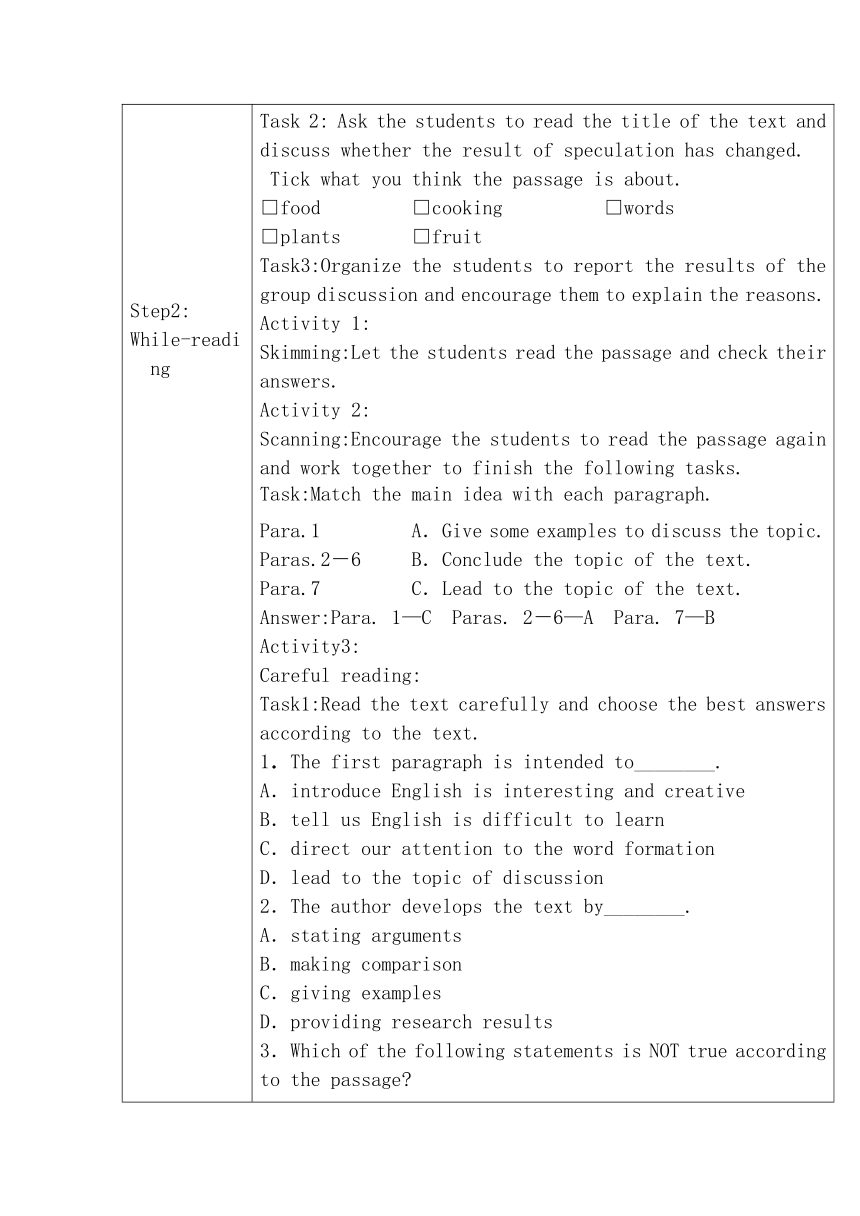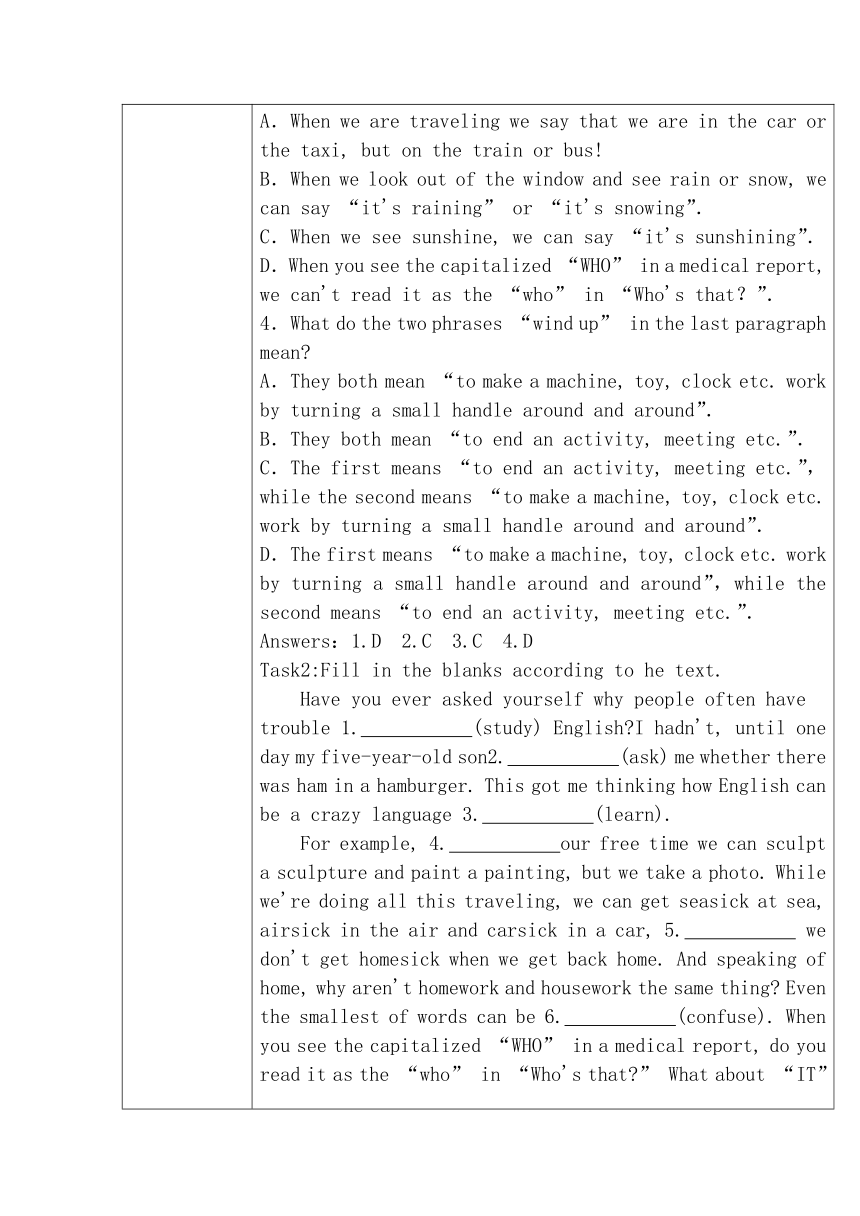外研版(2019)必修第一册Unit2 Exploring English Period2 Understanding ideas教案(表格式)
文档属性
| 名称 | 外研版(2019)必修第一册Unit2 Exploring English Period2 Understanding ideas教案(表格式) |

|
|
| 格式 | docx | ||
| 文件大小 | 25.4KB | ||
| 资源类型 | 教案 | ||
| 版本资源 | 外研版(2019) | ||
| 科目 | 英语 | ||
| 更新时间 | 2023-07-11 20:02:55 | ||
图片预览



文档简介
Unit2 Exploring English Period2 Understanding ideas教案
Topic Neither Pine nor Apple in Pineapple Teacher
Teaching Aims: 1.Get the students to learn some useful new words and expressions in this part. 2.Develop the students’ reading skills and enable them to learn how to use different reading strategies to read different reading materials. 3.Guide the students to feel the humor, "madness" and creativity of English language,and stimulating their interest in English leaning.
Teaching important Points: Lead the students to obtain the general idea of the text through skimming and intensive reading. Let the students master the key words and phrases in this part. Guide the students to understand the wonders of English and the cultural connotations behind English words.
Teaching difficult points: 1.Let the students learn to analyze and solve problems ,and improve their reading level. 2.Guide the students to understand the meaning of the title. 3. Guide the students to establish a correct view of English learning based on the content of the text.
Teaching methods: Task-based Language Teaching Question-inquiry Teaching
Teaching type: Reading 课 时 one
Teaching procedure: Teaching contents:
Step1: Pre-reading Step2: While-reading Step3: Post-reading Summary Task 1:Encourage the students to look at the pictures, discuss the information expressed by the formulas in the pictures and speculate the content of the text. Task 2: Ask the students to read the title of the text and discuss whether the result of speculation has changed. Tick what you think the passage is about. □food □cooking □words □plants □fruit Task3:Organize the students to report the results of the group discussion and encourage them to explain the reasons. Activity 1: Skimming:Let the students read the passage and check their answers. Activity 2: Scanning:Encourage the students to read the passage again and work together to finish the following tasks. Task:Match the main idea with each paragraph. Para.1 A.Give some examples to discuss the topic. Paras.2-6 B.Conclude the topic of the text. Para.7 C.Lead to the topic of the text. Answer:Para. 1—C Paras. 2-6—A Para. 7—B Activity3: Careful reading: Task1:Read the text carefully and choose the best answers according to the text. 1.The first paragraph is intended to________. A.introduce English is interesting and creative B.tell us English is difficult to learn C.direct our attention to the word formation D.lead to the topic of discussion 2.The author develops the text by________. A.stating arguments B.making comparison C.giving examples D.providing research results 3.Which of the following statements is NOT true according to the passage A.When we are traveling we say that we are in the car or the taxi, but on the train or bus! B.When we look out of the window and see rain or snow, we can say “it's raining” or “it's snowing”. C.When we see sunshine, we can say “it's sunshining”. D.When you see the capitalized “WHO” in a medical report, we can't read it as the “who” in “Who's that?”. 4.What do the two phrases “wind up” in the last paragraph mean A.They both mean “to make a machine, toy, clock etc. work by turning a small handle around and around”. B.They both mean “to end an activity, meeting etc.”. C.The first means “to end an activity, meeting etc.”,while the second means “to make a machine, toy, clock etc. work by turning a small handle around and around”. D.The first means “to make a machine, toy, clock etc. work by turning a small handle around and around”,while the second means “to end an activity, meeting etc.”. Answers:1.D 2.C 3.C 4.D Task2:Fill in the blanks according to he text. Have you ever asked yourself why people often have trouble 1. (study) English I hadn't, until one day my five-year-old son2. (ask) me whether there was ham in a hamburger. This got me thinking how English can be a crazy language 3. (learn). For example, 4. our free time we can sculpt a sculpture and paint a painting, but we take a photo. While we're doing all this traveling, we can get seasick at sea, airsick in the air and carsick in a car, 5. we don't get homesick when we get back home. And speaking of home, why aren't homework and housework the same thing Even the smallest of words can be 6. (confuse). When you see the capitalized “WHO” in a medical report, do you read it as the “who” in “Who's that ” What about “IT” and “US” English 7. (invent) by people,not computers, and it reflects the 8. (creative) of the human race. That is 9. when the stars are out, they are visible, but when the lights are out, they are10. (visible). Answers:1.studying 2.asked 3.to learn 4.in 5.but 6.confusing 7.was invented 8.creativity 9.why 10.invisible Task1:Let the students choose the author's purpose in writing the passage. To tell us that English is very difficult to learn. To give advice on how to learn English. To show that English is interesting and creative. To explain how English was created. Answer:3. Task2:Ask the students to read the following information and answer the questions. The word“pineapple” developed from the Spanish word “pi a”,which means pine cone When it came to England, “apple” was added to show it is a kind of fruit. The origin of "hamburger” was a hard beef steak called“Hamburg steak”, eaten without bread. Later, people reinvented it and called it“hamburger”. Eggplants used to be smaller and yellow or white. They looked a bit like eggs, which led to the name “eggplant". 1. How did pineapples, hamburgers and eggplants get their names 2. Does the information above give you a better understanding of the passage Give your reasons. Answers: The name of "pineapple" developed from the Spanish word "pi a",with "apple" added to show it's a kind of fruit;the name of hamburger came from the idea of "Hamburg steak", and later people reinvented it and called it "hamburger"; eggplants got the name because they used to look like eggs. Students' own answers. This lesson successfully completed the pre-set tasks and achieved good effects.
Homework Review this lesson and complete the following questions. Do you agree with the author's opinion about the English language Give your reasons. What do you find most challenging about learning English How do you deal with this
Blackboard design Neither Pine nor Apple in Pineapple opposing adj.相反的,相对的 opposed adj.截然不同的 opposite adj.相对的,相反的; prep.在…对面;adv.在对面 behavior n. 举止,行为 behave oneself举止良好 confusing adj.(事/物)令人困惑的 confused adj.(人)感到困惑的 confusion n.困惑 reflect vt. & vi. 显示,反映;反射 reflection n.反映,反射 reflect on 反省 have trouble/difficulty/problems(in)doing sth. 做某事有困难 have trouble/difficulty/problems with sth. 在某方面有困难 6.neither...nor...“既不……也不” 连接句中两个并列的句子成分。当连接并列主语时,谓语动词遵循就近原则。
Topic Neither Pine nor Apple in Pineapple Teacher
Teaching Aims: 1.Get the students to learn some useful new words and expressions in this part. 2.Develop the students’ reading skills and enable them to learn how to use different reading strategies to read different reading materials. 3.Guide the students to feel the humor, "madness" and creativity of English language,and stimulating their interest in English leaning.
Teaching important Points: Lead the students to obtain the general idea of the text through skimming and intensive reading. Let the students master the key words and phrases in this part. Guide the students to understand the wonders of English and the cultural connotations behind English words.
Teaching difficult points: 1.Let the students learn to analyze and solve problems ,and improve their reading level. 2.Guide the students to understand the meaning of the title. 3. Guide the students to establish a correct view of English learning based on the content of the text.
Teaching methods: Task-based Language Teaching Question-inquiry Teaching
Teaching type: Reading 课 时 one
Teaching procedure: Teaching contents:
Step1: Pre-reading Step2: While-reading Step3: Post-reading Summary Task 1:Encourage the students to look at the pictures, discuss the information expressed by the formulas in the pictures and speculate the content of the text. Task 2: Ask the students to read the title of the text and discuss whether the result of speculation has changed. Tick what you think the passage is about. □food □cooking □words □plants □fruit Task3:Organize the students to report the results of the group discussion and encourage them to explain the reasons. Activity 1: Skimming:Let the students read the passage and check their answers. Activity 2: Scanning:Encourage the students to read the passage again and work together to finish the following tasks. Task:Match the main idea with each paragraph. Para.1 A.Give some examples to discuss the topic. Paras.2-6 B.Conclude the topic of the text. Para.7 C.Lead to the topic of the text. Answer:Para. 1—C Paras. 2-6—A Para. 7—B Activity3: Careful reading: Task1:Read the text carefully and choose the best answers according to the text. 1.The first paragraph is intended to________. A.introduce English is interesting and creative B.tell us English is difficult to learn C.direct our attention to the word formation D.lead to the topic of discussion 2.The author develops the text by________. A.stating arguments B.making comparison C.giving examples D.providing research results 3.Which of the following statements is NOT true according to the passage A.When we are traveling we say that we are in the car or the taxi, but on the train or bus! B.When we look out of the window and see rain or snow, we can say “it's raining” or “it's snowing”. C.When we see sunshine, we can say “it's sunshining”. D.When you see the capitalized “WHO” in a medical report, we can't read it as the “who” in “Who's that?”. 4.What do the two phrases “wind up” in the last paragraph mean A.They both mean “to make a machine, toy, clock etc. work by turning a small handle around and around”. B.They both mean “to end an activity, meeting etc.”. C.The first means “to end an activity, meeting etc.”,while the second means “to make a machine, toy, clock etc. work by turning a small handle around and around”. D.The first means “to make a machine, toy, clock etc. work by turning a small handle around and around”,while the second means “to end an activity, meeting etc.”. Answers:1.D 2.C 3.C 4.D Task2:Fill in the blanks according to he text. Have you ever asked yourself why people often have trouble 1. (study) English I hadn't, until one day my five-year-old son2. (ask) me whether there was ham in a hamburger. This got me thinking how English can be a crazy language 3. (learn). For example, 4. our free time we can sculpt a sculpture and paint a painting, but we take a photo. While we're doing all this traveling, we can get seasick at sea, airsick in the air and carsick in a car, 5. we don't get homesick when we get back home. And speaking of home, why aren't homework and housework the same thing Even the smallest of words can be 6. (confuse). When you see the capitalized “WHO” in a medical report, do you read it as the “who” in “Who's that ” What about “IT” and “US” English 7. (invent) by people,not computers, and it reflects the 8. (creative) of the human race. That is 9. when the stars are out, they are visible, but when the lights are out, they are10. (visible). Answers:1.studying 2.asked 3.to learn 4.in 5.but 6.confusing 7.was invented 8.creativity 9.why 10.invisible Task1:Let the students choose the author's purpose in writing the passage. To tell us that English is very difficult to learn. To give advice on how to learn English. To show that English is interesting and creative. To explain how English was created. Answer:3. Task2:Ask the students to read the following information and answer the questions. The word“pineapple” developed from the Spanish word “pi a”,which means pine cone When it came to England, “apple” was added to show it is a kind of fruit. The origin of "hamburger” was a hard beef steak called“Hamburg steak”, eaten without bread. Later, people reinvented it and called it“hamburger”. Eggplants used to be smaller and yellow or white. They looked a bit like eggs, which led to the name “eggplant". 1. How did pineapples, hamburgers and eggplants get their names 2. Does the information above give you a better understanding of the passage Give your reasons. Answers: The name of "pineapple" developed from the Spanish word "pi a",with "apple" added to show it's a kind of fruit;the name of hamburger came from the idea of "Hamburg steak", and later people reinvented it and called it "hamburger"; eggplants got the name because they used to look like eggs. Students' own answers. This lesson successfully completed the pre-set tasks and achieved good effects.
Homework Review this lesson and complete the following questions. Do you agree with the author's opinion about the English language Give your reasons. What do you find most challenging about learning English How do you deal with this
Blackboard design Neither Pine nor Apple in Pineapple opposing adj.相反的,相对的 opposed adj.截然不同的 opposite adj.相对的,相反的; prep.在…对面;adv.在对面 behavior n. 举止,行为 behave oneself举止良好 confusing adj.(事/物)令人困惑的 confused adj.(人)感到困惑的 confusion n.困惑 reflect vt. & vi. 显示,反映;反射 reflection n.反映,反射 reflect on 反省 have trouble/difficulty/problems(in)doing sth. 做某事有困难 have trouble/difficulty/problems with sth. 在某方面有困难 6.neither...nor...“既不……也不” 连接句中两个并列的句子成分。当连接并列主语时,谓语动词遵循就近原则。
